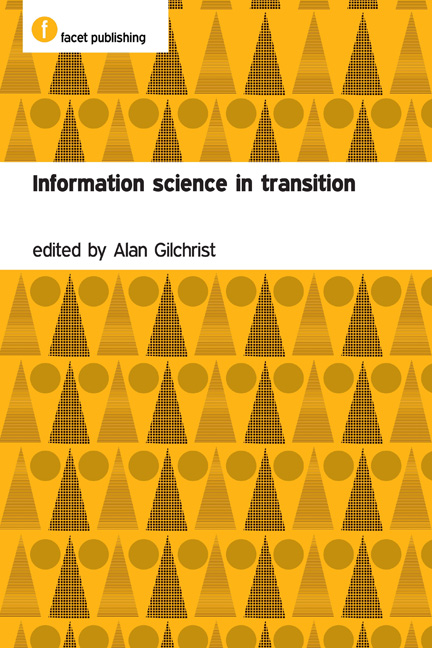Book contents
- Frontmatter
- Contents
- Contributors
- Preface
- Editorial
- Guest Editorial: Meeting the challenge
- 1 Fifty years of UK research in information science
- 2 Smoother pebbles and the shoulders of giants: the developing foundations of information science
- 3 The last 50 years of knowledge organization: a journey through my personal archives
- 4 On the history of evaluation in IR
- 5 The information user: past, present and future
- 6 The sociological turn in information science
- 7 From chemical documentation to chemoinformatics: 50 years of chemical information science
- 8 Health informatics: current issues and challenges
- 9 Social informatics and sociotechnical research – a view from the UK
- 10 The evolution of visual information retrieval
- 11 Information policies: yesterday, today, tomorrow
- 12 The disparity in professional qualifications and progress in information handling: a European perspective
- 13 Electronic scholarly publishing and Open Access
- 14 Social software: fun and games, or business tools?
- 15 Bibliometrics to webometrics
- 16 How I learned to love the Brits
- Index
10 - The evolution of visual information retrieval
Published online by Cambridge University Press: 08 June 2018
- Frontmatter
- Contents
- Contributors
- Preface
- Editorial
- Guest Editorial: Meeting the challenge
- 1 Fifty years of UK research in information science
- 2 Smoother pebbles and the shoulders of giants: the developing foundations of information science
- 3 The last 50 years of knowledge organization: a journey through my personal archives
- 4 On the history of evaluation in IR
- 5 The information user: past, present and future
- 6 The sociological turn in information science
- 7 From chemical documentation to chemoinformatics: 50 years of chemical information science
- 8 Health informatics: current issues and challenges
- 9 Social informatics and sociotechnical research – a view from the UK
- 10 The evolution of visual information retrieval
- 11 Information policies: yesterday, today, tomorrow
- 12 The disparity in professional qualifications and progress in information handling: a European perspective
- 13 Electronic scholarly publishing and Open Access
- 14 Social software: fun and games, or business tools?
- 15 Bibliometrics to webometrics
- 16 How I learned to love the Brits
- Index
Summary
Abstract
This paper seeks to provide a brief overview of those developments which have taken the theory and practice of image and video retrieval into the digital age. Drawing on a voluminous literature, the context in which visual information retrieval takes place is followed by a consideration of the conceptual and practical challenges posed by the representation and recovery of visual material on the basis of its semantic content. An historical account of research endeavours in content-based retrieval, directed towards the automation of these operations in digital image scenarios, provides the main thrust of the paper. Finally, a look forwards locates visual information retrieval research within the wider context of content-based multimedia retrieval.
The context of visual information retrieval
The retrieval of images or image sequences that are relevant to a query is a long-established activity which has evolved quite remarkably during the last 50 years, from the special preserve of a relatively few professional practitioners to the forefront of research in computer vision and a leading edge domestic application of information technology. This extension of traditional information retrieval activity includes both still and moving images, the former usually characterized in the literature as ‘image retrieval’, the latter as ‘video retrieval’, and the two in combination, sometimes, as ‘visual information retrieval’ [1,2].
The literature of visual information retrieval has grown at a stupendous rate. To quote Jörgensen, in her landmark text within the field:
Adjectives such as ‘vast’ are often applied to the various literatures … related to image processing, but even this designation is an understatement [3: p. 199].
More remarkable still is the fact that almost all of that growth has taken place since the early 1990s, and reflects those technological advances which brought the digital image to the attention of the computer scientist. Greatly increased availability of images via the internet, then via mobile platforms, and most recently as an aspect of the social networking phenomenon, has been said to place us
on the hinge of an important historical swing back towards to what may be called the primacy of the image [3: p. ix].
- Type
- Chapter
- Information
- Information Science in Transition , pp. 221 - 248Publisher: FacetPrint publication year: 2009



